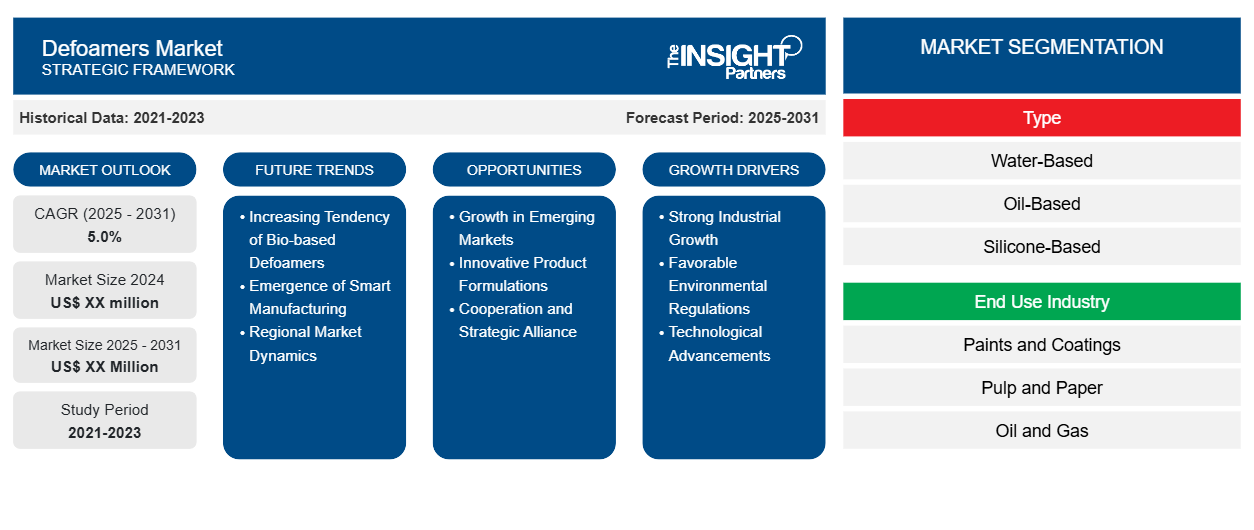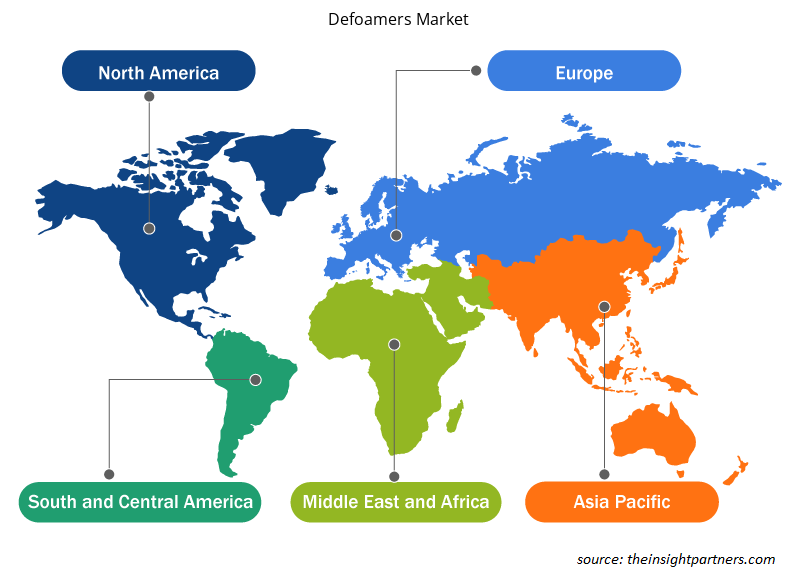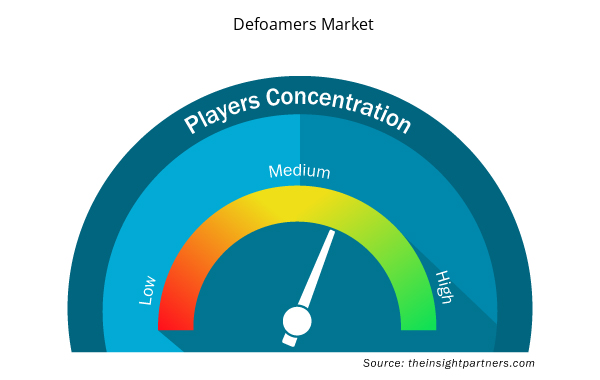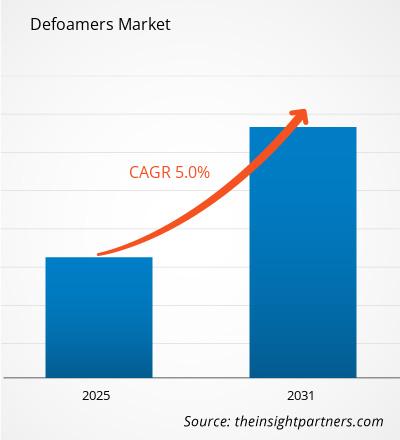Si prevede che il mercato degli antischiuma registrerà un CAGR del 5,0% dal 2025 al 2031, con una dimensione di mercato in espansione da XX milioni di dollari USA nel 2024 a XX milioni di dollari USA entro il 2031.
Il mercato degli antischiuma è segmentato in base a tipo, settore di utilizzo finale e area geografica. In base al tipo, il mercato è segmentato in base all'acqua, a base di olio, a base di silicone e altri. In base al settore di utilizzo finale, il mercato è segmentato in vernici e rivestimenti, cellulosa e carta, petrolio e gas, alimenti e bevande, tessile, prodotti farmaceutici, metallo e altri. L'ambito del rapporto copre cinque regioni: Nord America, Europa, Asia Pacifico, Medio Oriente e Africa e Sud e Centro America e paesi chiave in ciascuna regione. L'analisi globale è ulteriormente suddivisa a livello regionale e nei principali paesi. Il rapporto offre il valore in USD per l'analisi e i segmenti di cui sopra.
Scopo del rapporto
Il report Defoamers Market di The Insight Partners mira a descrivere il panorama attuale e la crescita futura, i principali fattori trainanti, le sfide e le opportunità. Ciò fornirà spunti a vari stakeholder aziendali, come:
- Fornitori/produttori di tecnologia: per comprendere le dinamiche di mercato in evoluzione e conoscere le potenziali opportunità di crescita, consentendo loro di prendere decisioni strategiche informate.
- Investitori: condurre un'analisi completa delle tendenze relative al tasso di crescita del mercato, alle proiezioni finanziarie del mercato e alle opportunità esistenti lungo la catena del valore.
- Enti di regolamentazione: regolamentano le politiche e le attività di controllo sul mercato allo scopo di ridurre al minimo gli abusi, preservare la fiducia degli investitori e sostenere l'integrità e la stabilità del mercato.
Segmentazione del mercato degli antischiuma
Tipo
- A base d'acqua
- A base di olio
- A base di silicone
- Altri
Settore di utilizzo finale
- Vernici e rivestimenti
- Polpa e carta
- Petrolio e gas
- Cibo e bevande
- Tessile
- Prodotti farmaceutici
- Metallo
- Altri
Personalizza questo report in base alle tue esigenze
Riceverai la personalizzazione gratuita di qualsiasi report, comprese parti di questo report, o analisi a livello nazionale, pacchetto dati Excel, oltre a usufruire di grandi offerte e sconti per start-up e università
Mercato degli antischiuma: approfondimenti strategici

- Scopri le principali tendenze di mercato in questo rapporto.Questo campione GRATUITO includerà analisi di dati che spaziano dalle tendenze di mercato alle stime e alle previsioni.
Fattori trainanti della crescita del mercato degli antischiuma
- Forte crescita industriale: in generale, la crescita di diversi settori come vernici e rivestimenti, prodotti farmaceutici, alimenti e bevande e cura della persona ha aumentato notevolmente la domanda del prodotto. Poiché questi settori si concentrano sulla qualità e sulle prestazioni dei prodotti, la necessità di agenti antischiuma che rimuovano la schiuma durante la produzione risulta estremamente indispensabile.
- Normative ambientali favorevoli: le crescenti normative ambientali sulle emissioni e sulle operazioni di smaltimento dei rifiuti stanno costringendo le industrie manifatturiere a modificare i loro processi e ad adottare pratiche più rispettose dell'ambiente. Pertanto, la maggior parte delle aziende sta adottando antischiuma a base d'acqua e biodegradabili per soddisfare gli obiettivi di sostenibilità delle proprie attività e limitare il loro impatto sull'ambiente.
- Progressi tecnologici: l'innovazione nelle formulazioni chimiche ha creato una classe di agenti antischiuma più efficaci e appositamente progettati. Le tecnologie più recenti migliorano le prestazioni in molte applicazioni e le aziende sono ora in grado di selezionare prodotti specifici che sono stati adattati alle loro particolari condizioni operative, guidando così il mercato.
Tendenze future del mercato degli antischiuma
- Tendenza crescente di antischiuma di origine biologica: la tendenza nel mercato globale degli antischiuma ultimamente è stata quella di orientarsi verso antischiuma di origine biologica con una maggiore consapevolezza dei consumatori sui prodotti sostenibili e la pressione delle normative. I produttori stanno cercando di formulare formulazioni basate su fonti naturali che sono considerate più sicure e più rispettose dell'ambiente.
- Emersione della produzione intelligente: le tecnologie intelligenti sono rapidamente diventate comuni nei processi di produzione. Tale sviluppo ha avuto un impatto anche sul mercato degli antischiuma, poiché le aziende sfruttano il monitoraggio in tempo reale e l'analisi dei dati per migliorare il controllo delle schiume nelle loro operazioni, portando quindi a una maggiore efficienza e a minori sprechi.
- Dinamiche del mercato regionale: il mercato degli antischiuma sta assistendo a cambiamenti nella domanda regionale, principalmente nella regione Asia-Pacifico. L'industrializzazione e l'urbanizzazione in India e Cina stanno creando un forte flusso di domanda per gli stessi in varie applicazioni, rendendo quest'area attraente per l'espansione.
Opportunità di mercato per gli antischiuma
- Crescita nei mercati emergenti: mercati molto attivi, le economie dell'Asia-Pacifico, dell'America Latina e del Medio Oriente sono economie in crescita che aumentano le opportunità di crescita per il mercato globale. Si prevede che la domanda di antischiuma aumenterà quando queste regioni continueranno a sviluppare i loro settori industriali.
- Formulazioni di prodotti innovativi: innovazione di formulazione Le aziende che investono in R&S per lo sviluppo di formulazioni antischiuma avanzate per sfide specifiche in varie applicazioni possono conquistare una nicchia di mercato. Le soluzioni su misura per processi di produzione unici o per le esigenze specifiche di un prodotto saranno un punto di forza competitivo.
- Cooperazione e alleanza strategica: un'alleanza strategica con gli utenti finali che producono antischiuma aprirà nuove strade di crescita. L'attenzione su una soluzione personalizzata sviluppata per applicazioni speciali può aumentare la fedeltà tra i clienti e aprire nuovi segmenti di mercato.
Approfondimenti regionali sul mercato degli antischiuma
Le tendenze regionali e i fattori che influenzano il mercato dei Defoamers durante il periodo di previsione sono stati ampiamente spiegati dagli analisti di Insight Partners. Questa sezione discute anche i segmenti e la geografia del mercato dei Defoamers in Nord America, Europa, Asia Pacifico, Medio Oriente e Africa, e Sud e Centro America.

- Ottieni i dati specifici regionali per il mercato degli antischiuma
Ambito del rapporto di mercato sugli antischiuma
| Attributo del report | Dettagli |
|---|---|
| Dimensioni del mercato nel 2024 | XX milioni di dollari USA |
| Dimensioni del mercato entro il 2031 | XX milioni di dollari USA |
| CAGR globale (2025 - 2031) | 5,0% |
| Dati storici | 2021-2023 |
| Periodo di previsione | 2025-2031 |
| Segmenti coperti | Per tipo
|
| Regioni e Paesi coperti | America del Nord
|
| Leader di mercato e profili aziendali chiave |
|
Densità dei player del mercato degli antischiuma: comprendere il suo impatto sulle dinamiche aziendali
Il mercato dei Defoamers Market sta crescendo rapidamente, spinto dalla crescente domanda degli utenti finali dovuta a fattori quali l'evoluzione delle preferenze dei consumatori, i progressi tecnologici e una maggiore consapevolezza dei benefici del prodotto. Con l'aumento della domanda, le aziende stanno ampliando le loro offerte, innovando per soddisfare le esigenze dei consumatori e capitalizzando sulle tendenze emergenti, il che alimenta ulteriormente la crescita del mercato.
La densità degli operatori di mercato si riferisce alla distribuzione di aziende o società che operano in un particolare mercato o settore. Indica quanti concorrenti (operatori di mercato) sono presenti in un dato spazio di mercato in relazione alle sue dimensioni o al valore di mercato totale.
Le principali aziende che operano nel mercato degli antischiuma sono:
- Prodotti e prodotti chimici dell'aria, Inc.
- Terra di Ash
- BASF SE
- Clariante
- DowDuPont
Disclaimer : le aziende elencate sopra non sono classificate secondo un ordine particolare.

- Ottieni una panoramica dei principali attori del mercato dei defoamers
Punti chiave di vendita
- Copertura completa: il rapporto esamina in modo completo i prodotti, i servizi, le tipologie e gli utenti finali del mercato degli antischiuma, fornendo una panoramica olistica.
- Analisi degli esperti: il rapporto è compilato sulla base della conoscenza approfondita di esperti e analisti del settore.
- Informazioni aggiornate: il rapporto garantisce la pertinenza aziendale grazie alla copertura di informazioni recenti e tendenze nei dati.
- Opzioni di personalizzazione: questo report può essere personalizzato per soddisfare le esigenze specifiche del cliente e adattarsi in modo appropriato alle strategie aziendali.
Il rapporto di ricerca sul mercato dei Defoamers può quindi aiutare a guidare il percorso di decodificazione e comprensione dello scenario del settore e delle prospettive di crescita. Sebbene possano esserci alcune preoccupazioni valide, i vantaggi complessivi di questo rapporto tendono a superare gli svantaggi.
- Analisi storica (2 anni), anno base, previsione (7 anni) con CAGR
- Analisi PEST e SWOT
- Valore/volume delle dimensioni del mercato - Globale, regionale, nazionale
- Industria e panorama competitivo
- Set di dati Excel



Report Coverage
Revenue forecast, Company Analysis, Industry landscape, Growth factors, and Trends

Segment Covered
This text is related
to segments covered.

Regional Scope
North America, Europe, Asia Pacific, Middle East & Africa, South & Central America

Country Scope
This text is related
to country scope.
Domande frequenti
The report can be delivered in PDF/Word format, we can also share excel data sheet based on request.
On the basis of geography, the defoamers market is classified into North America, Europe, Asia Pacific, Middle East and Africa, and South and Central America
BASF SE, Evonik, Ashland, Wacker Chemie AG, Ecolab, Shin-Etsu Chemical Co., Ltd., Kemira, CLARIANT, Croda International Plc, and Accepta Water Treatmentare some of the players operating in the market.
The Defoamers Market is estimated to witness a CAGR of 5.0% from 2023 to 2031
The major factors driving the defoamers market are:
1.Industrial Growth
2. Environmental Regulations
Shift towards bio-based defoamers is expected to be the key market trend.
Trends and growth analysis reports related to Chemicals and Materials : READ MORE..
The List of Companies
1. Air Products and Chemicals, Inc
2. Ashland
3. BASF SE
4. Clariant
5. DowDuPont
6. Elementis plc
7. Elkem Silicones
8. Evonik Industries AG
9. KCC Basildon
10. Wacker Chemie AG
The Insight Partners performs research in 4 major stages: Data Collection & Secondary Research, Primary Research, Data Analysis and Data Triangulation & Final Review.
- Data Collection and Secondary Research:
As a market research and consulting firm operating from a decade, we have published and advised several client across the globe. First step for any study will start with an assessment of currently available data and insights from existing reports. Further, historical and current market information is collected from Investor Presentations, Annual Reports, SEC Filings, etc., and other information related to company’s performance and market positioning are gathered from Paid Databases (Factiva, Hoovers, and Reuters) and various other publications available in public domain.
Several associations trade associates, technical forums, institutes, societies and organization are accessed to gain technical as well as market related insights through their publications such as research papers, blogs and press releases related to the studies are referred to get cues about the market. Further, white papers, journals, magazines, and other news articles published in last 3 years are scrutinized and analyzed to understand the current market trends.
- Primary Research:
The primarily interview analysis comprise of data obtained from industry participants interview and answers to survey questions gathered by in-house primary team.
For primary research, interviews are conducted with industry experts/CEOs/Marketing Managers/VPs/Subject Matter Experts from both demand and supply side to get a 360-degree view of the market. The primary team conducts several interviews based on the complexity of the markets to understand the various market trends and dynamics which makes research more credible and precise.
A typical research interview fulfils the following functions:
- Provides first-hand information on the market size, market trends, growth trends, competitive landscape, and outlook
- Validates and strengthens in-house secondary research findings
- Develops the analysis team’s expertise and market understanding
Primary research involves email interactions and telephone interviews for each market, category, segment, and sub-segment across geographies. The participants who typically take part in such a process include, but are not limited to:
- Industry participants: VPs, business development managers, market intelligence managers and national sales managers
- Outside experts: Valuation experts, research analysts and key opinion leaders specializing in the electronics and semiconductor industry.
Below is the breakup of our primary respondents by company, designation, and region:

Once we receive the confirmation from primary research sources or primary respondents, we finalize the base year market estimation and forecast the data as per the macroeconomic and microeconomic factors assessed during data collection.
- Data Analysis:
Once data is validated through both secondary as well as primary respondents, we finalize the market estimations by hypothesis formulation and factor analysis at regional and country level.
- Macro-Economic Factor Analysis:
We analyse macroeconomic indicators such the gross domestic product (GDP), increase in the demand for goods and services across industries, technological advancement, regional economic growth, governmental policies, the influence of COVID-19, PEST analysis, and other aspects. This analysis aids in setting benchmarks for various nations/regions and approximating market splits. Additionally, the general trend of the aforementioned components aid in determining the market's development possibilities.
- Country Level Data:
Various factors that are especially aligned to the country are taken into account to determine the market size for a certain area and country, including the presence of vendors, such as headquarters and offices, the country's GDP, demand patterns, and industry growth. To comprehend the market dynamics for the nation, a number of growth variables, inhibitors, application areas, and current market trends are researched. The aforementioned elements aid in determining the country's overall market's growth potential.
- Company Profile:
The “Table of Contents” is formulated by listing and analyzing more than 25 - 30 companies operating in the market ecosystem across geographies. However, we profile only 10 companies as a standard practice in our syndicate reports. These 10 companies comprise leading, emerging, and regional players. Nonetheless, our analysis is not restricted to the 10 listed companies, we also analyze other companies present in the market to develop a holistic view and understand the prevailing trends. The “Company Profiles” section in the report covers key facts, business description, products & services, financial information, SWOT analysis, and key developments. The financial information presented is extracted from the annual reports and official documents of the publicly listed companies. Upon collecting the information for the sections of respective companies, we verify them via various primary sources and then compile the data in respective company profiles. The company level information helps us in deriving the base number as well as in forecasting the market size.
- Developing Base Number:
Aggregation of sales statistics (2020-2022) and macro-economic factor, and other secondary and primary research insights are utilized to arrive at base number and related market shares for 2022. The data gaps are identified in this step and relevant market data is analyzed, collected from paid primary interviews or databases. On finalizing the base year market size, forecasts are developed on the basis of macro-economic, industry and market growth factors and company level analysis.
- Data Triangulation and Final Review:
The market findings and base year market size calculations are validated from supply as well as demand side. Demand side validations are based on macro-economic factor analysis and benchmarks for respective regions and countries. In case of supply side validations, revenues of major companies are estimated (in case not available) based on industry benchmark, approximate number of employees, product portfolio, and primary interviews revenues are gathered. Further revenue from target product/service segment is assessed to avoid overshooting of market statistics. In case of heavy deviations between supply and demand side values, all thes steps are repeated to achieve synchronization.
We follow an iterative model, wherein we share our research findings with Subject Matter Experts (SME’s) and Key Opinion Leaders (KOLs) until consensus view of the market is not formulated – this model negates any drastic deviation in the opinions of experts. Only validated and universally acceptable research findings are quoted in our reports.
We have important check points that we use to validate our research findings – which we call – data triangulation, where we validate the information, we generate from secondary sources with primary interviews and then we re-validate with our internal data bases and Subject matter experts. This comprehensive model enables us to deliver high quality, reliable data in shortest possible time.

 Ottieni un campione gratuito per questo repot
Ottieni un campione gratuito per questo repot